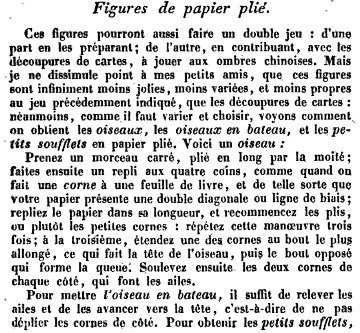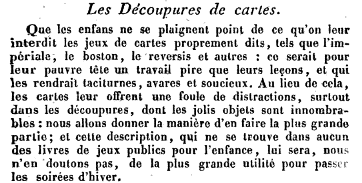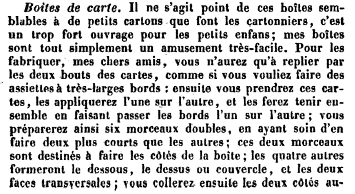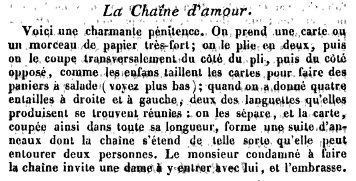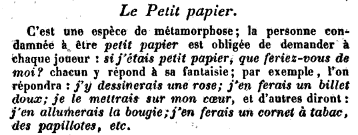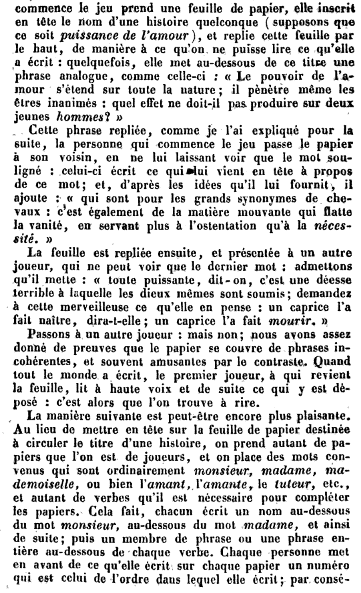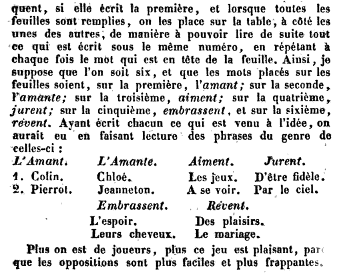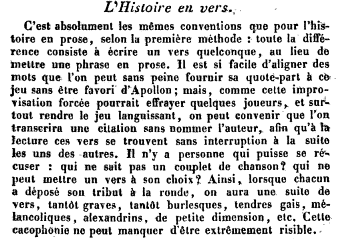| The Public Paperfolding History Project
x |
|||||||
| Manuel Complet des Jeux de Société by Elisabeth Celnart, 1827 | |||||||
| 'Manuel
Complet des Jeux de Société' by Elisabeth Celnart (a
pseudonym of Elisabeth Félicie Bayle-Mouillard née
Canard) was published by La Librairie Encyclopedique de
Roret in Paris in 1827. The information on this page is taken from the revised and expanded third edition, published in 1836. According to Joan Sallas, who possesses a copy of the first edition, the 'Figures de papier plies' material in the third edition is identical to that in the first. I have assumed that the other material is also identical but have not been able to verify this. There are no illustrations. A full copy of the 1836 third edition can be viewed online at https://books.google.fr/books?id=85FJAAAAYAAJ The book contains: Figures de papier plies (Paperfolded figures) This section contains instructions for making a bird, a bird in a boat and a small bellows. Translation into English by Edwin Corrie. The instructions for making the bird say 'Take a square piece, folded lengthwise in half, then fold over the four corners, like making a dog-ear on the page of a book, and so that your paper has a double diagonal or oblique line, and repeat the folds, or rather the small dog-ear corners: repeat this manoeuvre three times. When you fold for the third time pull out one of the dog-ear corners at the longest end, which makes the head of the bird, then the opposite end which forms the tail, then lift the two dog-ear corners on each side, which make the wings.' Setting aside for a while the requirement to 'Fold the paper lengthwise', these instructions appear to explain how to make a Cocotte / Pajarita (the version that would now be folded from a blintzed windmill base), except that no mention is made of the necessity to reverse fold the head. The instruction 'Fold the paper lengthwise' seems to be redundant since the double diagonal provides the location point for the second set of blintzes. The instructions for transforming the bird into the bird in a boat say 'To change the bird into a boat, simply raise the wings and to move them towards the head, without unfolding the dog-ears at the sides.'Following these instructions results in a design similar to the boat with sail, except that the top of the sail is folded forwards so that it still resembles the head of a bird. I call this design the Cocotte / Pajarita in a Boat. As far as I am aware it does not occur elsewhere. The instructions for making the Small Bellows say, 'To get the small bellows we make a square folded three times, as if to start the bird; then spread the middle, raise it above and below, and squeeze the two ends together by pinching them.' These instructions do not lead to the design that is commonly known as the Bellows. It seems more likely to me that they are intended to lead to a blintzed version of the preliminary fold (which can be opened and closed a little like a bellows) or that, just possibly, they are a poor description of how to fold the Salt-Cellar (which can be operated in a similar way). Lacking diagrams, however, it is impossible to make a definitive judgement. The final paragraph says 'Several other similar objects can be made, by folding the square of paper and folding in the corners three times: with this preparation made, you can obtain, by raising and arranging the folded corners, the object you have in mind.'
********** Les Decoupures de Cartes (Card Cut Outs) / Fold and Cut Card Designs The introduction reads, roughly, 'Let the children not complain that they are prohibited from playing card games proper, such as immoral, Boston, lo reversis and others: it would be harder work than their lessons, which would make them taciturn, miserable and anxious. Instead, the cards offer a host of distractions, especially the cut outs, whose pretty objects are innumerable: we will describe the way to make the best of them; and this description, which is not to be found in any of the public games books for children, will, we have no doubt, be of the greatest use for spending the winter evenings.' This is interesting because of the claim that this material cannot be found in previously published children's books.
*** Les Capuchins / The Playing Card Monk Roughly, 'Here is the simplest cutting of cards: wide at one end, pointed at the other, and slightly curved at the top, to keep it in balance, the Capuchin, which resembles a rifle bayonet, is a sort of card skittle; indeed, the children plant the Capuchins close to each other, and when one falls, the others fall in a row.'
*** Boites de Carte / The Playing Card Cube This version seems to be intended to be joined together using glue, with the lid attached using a ribbon. Roughly, 'It is not a question of making those small boxes made by cardboard manufacturers, which are too difficult for small children to make; my boxes are quite simply a very easy amusement. To make them, my dear friends, you will only have to fold the two ends of the cards, as if you wanted to make plates with very wide edges. Then you will take these, apply them one on the other, and make them hold together by passing the edges one over the other. You will thus prepare six double pieces, taking care to make two shorter than the others. These two pieces are intended to make the sides of the box. The other four will form the bottom, the top or cover, and the two transverse faces (ie the front and back). You will then glue the two sides to the bottom, which you want to do on a table, then the two other sides opposite each other. You will attach the cover at the end of one of the sides, passing, a few lines from each end, a shovel loop of ribbon, which you will tie a little loose to let the cover play, and you will have a very nice piece of furniture.'
*** This section also contains instructions for making other objects using cardboard modelling / cartonnage fold and cut techniques: Les fauteuils (The Armchairs) / Tables / Assiettes (Plates) / Corbeilles (Baskets) / Seaux (Buckets) / Paniers a salade (Salad Baskets) / Chaises (Chairs) / Les chaises a barreaux longes (Long Bar Chairs) / Maisonnette (Small House) / Chaine (Chain) ********** La Chaine d'amour (How to Climb Through a Playing Card) This is a forfeit in which a card is folded and cut to produce a continuous chain which is long enough to allow two people to climb into the middle and kiss.
********** Le Petit papier This is a simple game, not involving paperfolding per se, in which someone asks 'If I were a little paper what would you do with me?'. Among the suggested possible answers are 'un billet doux', 'un cornet a tabac' (a tobacco cone) and 'des papillotes' (a message wrapped around a confectionery, usually chocolate).
********** Write and Fold Games L'Histoire Two different versions of the game are given, one which is more or less in an open format and in which each successive player only sees the last word of what was previously written, and one in which each player adds information according to a previously agreed set of categories. The opening sentence says, roughly, 'The game of 'l'histoire' is the same as the game of 'l'amphigouri', 'roman impromptu' and 'secretaire' of which we speak later'. It does not appear to me as though the other games make use of paperfolding in the same way as 'l'histoire' does. The instructions are not always clear on this point, however.
*** L'Histoire en vers This is the same as the previous game except that what is written on the paper needs to be in verse.
********** |
